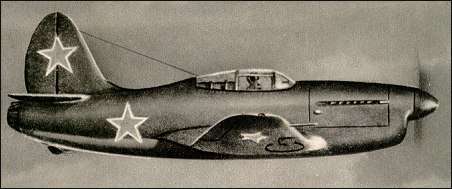|
| The development at the TsIAM (Central Aero Engine Institute) by K V Kholshchevnikov of the so-called "accelerator", or VRDK (Vozdushno-reaktivny dvigatyel kompressorny, or Air-reaction engine compressor), prompted the development of mixed-power single-seat fighters as an interim means of meeting the potential threat of German turbojet-powered fighters. Both Mikoyan-Gurevich and Sukhoi bureaux were assigned the task of creating such fighters, the former developing the MiG-13 alias I-250(N) and the latter the Su-5 alias I-107. The VRDK provided 300kg thrust for up to 10 min at high altitude to boost the power available from the Klimov M-107A (VK-107A)
12-cylinder Vee-type liquid-cooled engine which delivered 1,650hp for take-off. An all-metal stressed-skin single-seat monoplane with a monocoque fuselage, the Su-5 had an armament of one 23mm engine-mounted cannon and two 12.7mm machine guns. First flown in April 1945, the prototype was soon thereafter fitted with a new wing of laminar-flow type developed by the TsAGI, and during one subsequent flight test a speed of 793km/h was attained at 4350m, this being 25km/h faster than had been calculated for that altitude. The effect of the VRDK was a gain of 90km/h at low altitude rising to 110km/h at 7800m, at which it was anticipated that maximum speed would be 810km/h. Early in July 1945, before this speed could be attained, the M-107A engine suffered some damage in flight and when it was found to be irreparable, the Su-5 flight test programme was abandoned.
| WEIGHTS |
| Take-off weight | 3804 kg | 8386 lb |
| Empty weight | 2954 kg | 6512 lb |
| DIMENSIONS |
| Wingspan | 10.56 m | 35 ft 8 in |
| Length | 8.51 m | 28 ft 11 in |
| Height | 3.53 m | 12 ft 7 in |
| Wing area | 17.00 m2 | 182.99 sq ft |
| PERFORMANCE |
| Max. speed | 810 km/h | 503 mph |
| Range | 600 km | 373 miles |
 | A three-view drawing (1667 x 1303) |
|
Do you have any comments?
|
| 
COMPANY
PROFILE
All the World's Rotorcraft
|








